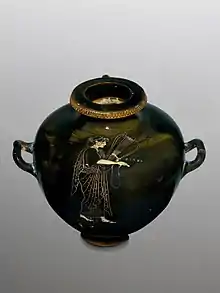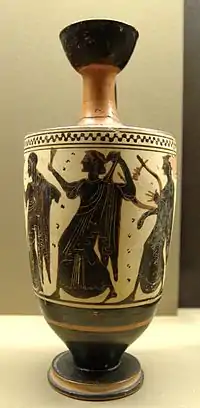Sappho Painter
Sappho Painter was an Attic black-figure vase painter, active c. 510–490 BCE.[1]

Kalpis (pottery), Sappho Painter, ca. 510 BC, National Museum, Warsaw
His name vase is a kalpis depicting the poet Sappho, currently held by the National Museum, Warsaw (Inv. 142333). The hand of the Sappho Painter has been identified on 95 vessels, 70% of which are lekythoi. His work has been also seen on tomb wall slabs and epinetra.[1]
Nearly half of his paintings are of the white-ground style. He apparently avoided the then-predominant red-figure technique, but sometimes used Six's technique whereby figures are laid on a black surface in white or red and details are incised so that the black shows through.[1] He was influenced and possibly trained by the Edinburgh Painter.[2]
References
- Mommsen, Heide, "Sappho Painter", in: Brill's New Pauly, Antiquity volumes edited by: Hubert Cancik and Helmuth Schneider
- Reeder Williams, Ellen (1984). The archaeological collection of the Johns Hopkins University. Johns Hopkins University Press. ISBN 978-0-8018-3050-1.
External links
 Media related to Sappho Painter at Wikimedia Commons
Media related to Sappho Painter at Wikimedia Commons- The Sappho Painter's name vase at The Beazley Archive, University of Oxford
This article is issued from Wikipedia. The text is licensed under Creative Commons - Attribution - Sharealike. Additional terms may apply for the media files.
